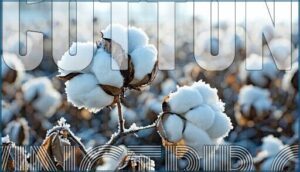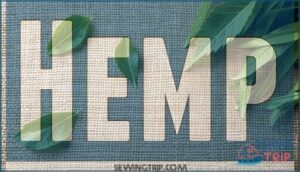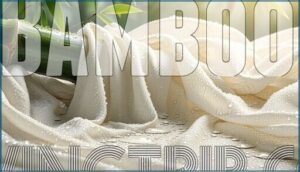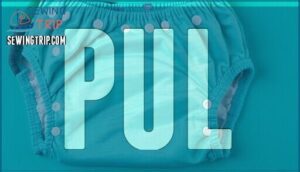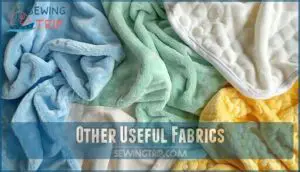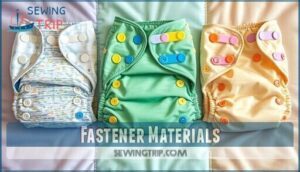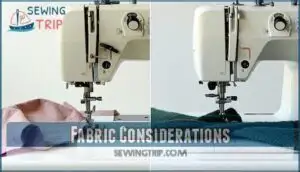This site is supported by our readers. We may earn a commission, at no cost to you, if you purchase through links.
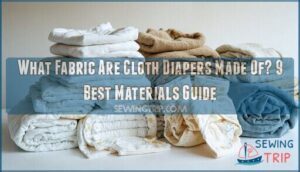 When you’re wondering what fabric are cloth diapers made of, you’ve got options that’ll make your head spin.
When you’re wondering what fabric are cloth diapers made of, you’ve got options that’ll make your head spin.
Cotton remains the gold standard, offering reliable absorption and easy washing. Hemp brings serious thirstiness to the table, while bamboo feels silky-soft against baby’s skin.
For the outer layer, you’ll find PUL (polyurethane laminate) or TPU keeping everything waterproof. Modal, fleece, and even wool join the party, each bringing unique benefits.
Some diapers mix and match these materials like a fabric cocktail. The secret isn’t just picking one material, but understanding how different fabrics work together to create the perfect diaper system for your little one’s needs.
Table Of Contents
Key Takeaways
- You’ll find three main fabric categories in cloth diapers: absorbent materials like cotton, hemp, and bamboo for soaking up moisture; waterproof fabrics like PUL and TPU for leak protection; and stay-dry liners like microfleece that wick wetness away from your baby’s skin.
- Hemp outperforms other fabrics for absorption, holding 2.5 times more liquid than cotton while naturally fighting bacteria, though bamboo offers the softest feel and cotton provides reliable breathability and easy washing.
- Your diaper works like a sandwich system with each layer serving a specific purpose – the absorbent core handles moisture, the waterproof barrier prevents leaks, and wicking layers keep your baby’s skin dry and comfortable.
- Organic and certified fabrics matter for sensitive skin – look for OEKO-TEX Standard 100 or GOTS certifications to ensure the materials are free from harmful chemicals and processed without harsh treatments that could irritate your baby.
Cloth Diaper Layers
You’ll find that cloth diapers work like a sandwich, with each layer serving a specific purpose to keep your baby dry and comfortable.
The absorbent layer soaks up moisture while the waterproof layer prevents leaks, and understanding these components helps you choose the right fabrics for your needs.
Absorbent Layer
The absorbent layer acts as your cloth diaper’s workhorse, soaking up moisture while keeping baby’s skin dry.
Your cloth diaper’s secret weapon: the absorbent layer that works overtime to keep your little one comfortable and dry.
This diaper inner layer determines how long you can go between changes, making absorbency the most critical factor in your diaper’s performance.
- Absorbent capacity varies dramatically between cloth diaper fabrics – hemp holds 20% more liquid than cotton
- Liquid distribution spreads moisture evenly across absorbent layers, preventing concentrated wet spots that cause leaks
- Drying times differ substantially – microfiber dries fastest while bamboo takes longest but offers superior absorbency
Smart parents layer different absorbency materials for maximum protection and comfort.
Waterproof Layer
While absorbent layers soak up moisture, your diaper’s waterproof layer acts as the final defense against leaks. This diaper outer layer keeps wetness contained while allowing your baby to stay comfortable and dry.
PUL diaper fabric remains the gold standard for waterproof fabrics, offering durability and easy bleaching. TPU provides superior flexibility and abrasion resistance. Breathable waterproofing options like fleece offer gentler coverage, while lanolized wool naturally repels moisture for heavy wetters.
For sensitive skin, consider bamboo rayon options as a soft alternative.
- Seam sealing prevents leaks at stitch lines
- Waterproof coatings enhance fabric performance
- PUL alternatives include TPU and treated fleece
- TPU durability withstands repeated washing cycles
- Breathable waterproofing balances protection with comfort
Absorbent Fabric Options
You’ll find four main fabric types that handle moisture absorption in cloth diapers, each with unique strengths for keeping your baby dry and comfortable.
Cotton offers reliable softness and breathability, while hemp provides superior absorbency, bamboo delivers eco-friendly moisture-wicking, and modal gives you luxurious feel with excellent durability.
These fabric types are chosen for their ability to keep your baby dry and comfortable, with each offering distinct benefits, including breathability.
Cotton
Cotton remains the gold standard for diaper cotton fabric.
You’ll find organic cotton offers superior breathability and gentleness compared to regular cotton types.
Cotton blends boost durability factors while maintaining softness.
Though cost analysis shows organic cotton costs more upfront, its longevity makes it worthwhile.
Pima cotton offers unmatched softness.
Cotton fabric’s natural fibers wick moisture effectively, keeping your baby comfortable and dry and providing superior breathability.
Hemp
When you’re hunting for superhero-strength diaper fabric, hemp delivers unmatched performance.
This powerhouse material boasts impressive hemp absorbency—holding 2.5 times more liquid than cotton while maintaining hemp durability that lasts years.
Hemp diaper fabric naturally fights bacteria, keeping your baby comfortable and rash-free.
Hemp blends with cotton create the perfect balance of strength and softness.
With proper hemp sourcing, you’ll enjoy eco-friendly hemp benefits that protect both baby and planet.
Hemp cloth diapers truly shine among absorbent diaper fabric types.
Given its high UV protection, hemp fabric also provides an extra layer of defense against the sun’s harmful rays.
Bamboo
You’ll love bamboo’s incredible absorbency—it soaks up 70% more liquid than cotton while staying naturally soft against baby’s skin.
This bamboo diaper fabric offers impressive durability and sustainability, though it’s technically rayon processed with chemicals.
Bamboo diapers also offer enhanced overnight absorbency, making them ideal for extended use.
Choose certified organic bamboo cloth diapers for the best combination of absorbent diaper fabric performance and eco-friendly peace of mind.
Modal
Derived from beech tree pulp, modal delivers exceptional modal softness that feels like silk against your baby’s skin.
This premium diaper fabric offers superior modal absorbency and modal wicking properties, pulling moisture away faster than cotton.
Modal durability means it won’t break down after countless washes.
While modal sourcing requires careful processing, certified organic options exist.
Among absorbent fabrics and fabric types, modal stands out as luxury diaper materials worth the investment for sensitive skin.
Waterproof Fabric Options
You’ll need a reliable waterproof barrier to prevent leaks, and the right fabric makes all the difference between soggy clothes and dry confidence.
Modern cloth diapers use specialized materials like PUL, TPU, fleece, and wool to create effective waterproof layers that keep moisture contained while maintaining breathability, which is crucial for dry confidence.
PUL
PUL stands as the gold standard for waterproof diaper fabric in modern cloth diapers.
This polyurethane laminate balances waterproof protection with breathability, keeping your baby dry while allowing airflow. PUL’s flexibility and durability make it perfect for active toddlers, though harsh detergents can reduce its lifespan over time.
Here’s what makes PUL special for diaper materials:
- Stretches like a second skin during those midnight diaper changes
- Repels liquids while letting moisture vapor escape naturally
- Withstands countless wash cycles without losing waterproof properties
- Feels soft against baby’s skin, not crinkly like plastic
- Maintains flexibility even after years of laundering and wear
TPU
TPU (thermoplastic polyurethane TPU) represents the next generation of waterproof diaper fabric.
This diaper fabric stretches like a second skin while keeping moisture locked away from your baby’s bottom.
TPU thickness varies, but it’s typically thinner than PUL while offering superior breathability.
TPU manufacturing creates a safer alternative without harmful chemicals.
When considering TPU alternatives, you’ll find this material excels in diaper layers requiring flexibility.
TPU durability guarantees long-lasting performance, and TPU safety makes it ideal for sensitive skin.
Fleece
Fleece offers a middle ground between PUL’s complete waterproofing and breathability needs.
This synthetic polyester material wicks moisture away from baby’s skin while allowing air circulation.
Microfleece works perfectly as staydry diaper fabric, creating comfortable fleece liners that prevent wetness against skin.
- Fleece Properties: Choose anti-pill varieties with soft napped surfaces for maximum comfort and fleece durability in your cloth diapers.
Wool
Wool covers offer natural waterproofing through lanolin treatments, creating breathable yet leak-proof protection.
You’ll find wool’s unique properties fascinating – it absorbs moisture while keeping baby’s skin dry.
Regular lanolizing maintains waterproofing effectiveness, though hand washing preserves durability best.
| Property | Wool Performance |
|---|---|
| Absorbency | Up to 30% of weight |
| Waterproofing | Natural lanolin barrier |
| Breathability | Excellent air circulation |
| Durability | Long-lasting with care |
| Maintenance | Hand wash, lanolize regularly |
Other Useful Fabrics
You’ll find several specialty fabrics that serve unique purposes in cloth diaper construction, particularly for keeping your baby’s skin dry and comfortable.
These materials, including microfleece and stay-dry liners, work alongside the main absorbent and waterproof layers to create a complete diaper system that wicks moisture away from sensitive skin.
Microfleece
This synthetic wonder creates the perfect stay-dry barrier between your baby’s skin and wet cloth diapers.
Microfleece properties make it ideal for pocket diaper linings, offering excellent cost effectiveness compared to other fleece diaper fabric options.
- Moisture-wicking magic: Pulls wetness away from skin into absorbent layers
- Pilling resistance: Maintains smooth texture through countless washes
- Gentle touch: Soft against delicate baby skin
Stay Dry Fabrics
Stay dry fabrics work like a one-way street for moisture.
Made from polyester, these staydry fabrics include suedecloth and microfleece that excel at moisturewicking.
Their superior wicking ability pulls wetness away from your baby’s skin, preventing skin irritation and chemical sensitivity issues.
The fabric softness feels gentle while staying dry to the touch.
Unlike materials prone to fabric pilling, these synthetic fabrics maintain their smooth texture wash after wash, ensuring a long-lasting and gentle feel.
Fastener Materials
While you’ve chosen the perfect fabrics for your cloth diaper’s layers, you’ll need reliable fasteners to keep everything secure during those inevitable wiggly diaper changes.
The three main fastener options—hook and loop, snaps, and snappis—each offer different benefits for durability, ease of use, and adjustability as your baby grows.
Hook and Loop
Hook and loop diaper fasteners offer adjustable sizing that grows with your baby.
However, traditional Velcro contains concerning perfluorinated chemicals. Choose safer alternatives made from polyester or nylon materials for peace of mind.
For various applications, consider exploring options for reliable fastener products.
Consider these hook and loop benefits for your cloth diaper sewing projects:
- Hook Durability – Withstands hundreds of wash cycles without losing grip
- Loop Softness – Gentle fabric won’t irritate delicate baby skin
- Closure Strength – Secure fit prevents embarrassing blowouts during playtime
- Industrial Applications – Proven reliability from medical and aerospace industries
Snaps
Metal snaps outlast plastic ones on cloth diapers, staying secure through blowouts and countless washes.
You’ll find strategic snap placement creates the perfect fit as your baby grows.
When snaps wear out, replacing them beats buying new diapers entirely. Consider where to source replacement diaper fasteners when repairs are needed.
Smart snap durability means fewer repairs, while thoughtful snap alternatives like hook and loop offer backup solutions for temperamental diaper fasteners, ensuring secure and reliable fastening options.
Snappis
With their plastic teeth gripping cloth diaper fabrics securely, snappis offer a stretchy alternative to traditional diaper closures.
These T-shaped fasteners accommodate growing babies while providing reliable hold.
- Snappi Safety: Plastic teeth won’t rust or break like pins
- Snappi Sizes: Available in different sizes for various cloth diapers
- Snappi Durability: Handwash and air dry to maintain grip strength
- Snappi Techniques: Hook at hips, adjust tension for comfort
- Snappi Alternatives: Consider hook-and-loop or snap fabric options
Fabric Considerations
When you’re choosing cloth diaper fabrics, you’ll need to take into account factors beyond just absorbency, including whether materials are organic, how they’re processed, what certifications they carry, their breathability, and their specific absorption rates.
These considerations affect everything from your baby’s comfort to your wallet, since some fabrics cost more upfront but last longer through multiple children, which can impact your overall wallet.
Organic
Beyond fasteners, you’ll want to keep in mind organic diaper fabric for your little one’s comfort.
Organic cotton uses no harsh pesticides, while natural fibers like hemp grow without synthetic chemicals.
These gentle fabrics cost more upfront but protect your baby’s sensitive skin from irritants.
| Material | Organic Benefit | Health Advantage |
|---|---|---|
| Organic Cotton | Pesticide-free growing | Reduced skin irritation |
| Hemp | Chemical-free processing | Natural antibacterial properties |
| Bamboo | Sustainable sourcing | Hypoallergenic texture |
| Wool | Eco-friendly dyes | Temperature regulation |
Natural diaper materials support both your family’s health and environmental responsibility.
Processing
When you’re shopping for organic diaper fabric, understanding textile production matters just as much as the raw materials.
Processing methods can transform natural fibers through chemical treatments that might surprise you.
Here’s what to watch for during diaper processing:
- Fiber Treatment – Some manufacturers use harsh chemicals to soften bamboo or cotton, potentially leaving residues
- Dyeing Methods – Synthetic dyes and bleaches can irritate sensitive skin, so look for undyed natural diaper materials
- Weaving Styles – Tight weaves may require more chemical fabric softening than loose, breathable constructions
Certifications
Beyond choosing the right cloth diapers fabric, you’ll want to look for trusted certifications that guarantee your baby’s safety.
These labels aren’t just fancy stickers—they’re your peace of mind in fabric form.
Here are four key certifications to seek out:
- OEKO-TEX Standard 100 – Tests for over 100 harmful substances in textiles
- GOTS Standard – Guarantees organic fibers meet strict environmental and social criteria
- Organic Certifications – Verifies natural fibers grown without pesticides or chemicals
- Fair Trade labels – Guarantees ethical production practices.
Chemical safety matters when synthetic materials and natural fibers touch your little one’s delicate skin daily.
Breathability
Natural fibers like cotton and bamboo create breathable diaper fabric that keeps your baby comfortable.
Their loose fabric weave allows airflow properties to prevent overheating while synthetic materials trap heat against delicate skin.
Choose cloth diapers with natural breathability for better temperature regulation and skin health.
Proper airflow prevents rashes and maintains comfort throughout wear time.
Absorbency Rates
Understanding absorbency rates helps you make smart fabric choices for your cloth diapers.
Different materials absorb moisture at varying speeds, affecting how dry your baby stays throughout the day.
Here’s how various diaper absorbency fabrics perform in absorption testing:
- Cotton absorbs 25-30 ml per gram with steady, deep moisture retention
- Hemp delivers 40-50 ml per gram with faster absorption than cotton
- Bamboo provides 35-40 ml per gram plus excellent moisture-wicking properties
- Microfiber achieves 60 ml per gram for rapid surface absorption
Layering impact matters—combining fast and slow absorbers maximizes absorbency retention. For enhanced softness, consider using Supima cotton options to make informed decisions about your cloth diapers.
Caring for Fabrics
You’ll need proper care techniques to keep your cloth diaper fabrics performing well, since different materials require specific washing methods and maintenance routines.
Following the right steps for washing cotton, hemp, and bamboo fabrics, plus lanolizing wool covers, guarantees your diapers stay absorbent, comfortable, and long-lasting throughout your baby’s diaper years.
Washing
Proper diaper washing keeps your cloth diapers performing like champs. You’ll want to wash every 2-3 days to prevent stains from setting.
Start with a cold rinse, then hot wash with cloth-safe detergent types. Skip fabric softeners – they’ll reduce absorbency faster than you can say "blowout."
| Wash Step | Water Temperature | Detergent Amount |
|---|---|---|
| Pre-rinse | Cold | None |
| Main wash | Hot (140°F) | Full amount |
| Extra rinse | Warm | None |
| Stain cycle | Hot | Enzyme booster |
| Final rinse | Cold | None |
Air drying methods work best for diaper maintenance.
Lanolizing
Lanolizing transforms your wool cloth diapers from absorbent material into waterproof protection.
This process involves dissolving pure lanolin in lukewarm water with mild soap, creating an emulsion that penetrates wool fibers.
The lanolin benefits include natural water resistance while maintaining breathability against baby’s skin.
For maximum purity, consider using refined lanolin products.
- Application methods: Gently squeeze the lanolin solution through wool covers, avoiding excessive wringing
- Re-lanolizing frequency: Reapply every 2-4 weeks when water no longer beads on the surface
- Lanolin types: Use medical-grade or breastfeeding lanolin from quality wool sources for best results
Finding Quality Materials
Once you’ve mastered caring for your cloth diapers, it’s time to focus on material sourcing for future purchases.
Quality materials make all the difference in your diapering journey.
Start with reputable retailers who provide detailed fabric properties information.
Look for companies that practice ethical production and offer durability testing results.
You’ll want suppliers who can explain their fabric blends and provide cost analysis comparisons.
Polyester offers exceptional durability and is a popular choice for diaper fabrics.
Check certifications like OEKO-TEX or GOTS for organic options.
These guarantee your reusable diaper material meets safety standards.
Test samples when possible – feel the texture, check absorbency rates, and examine stitching quality.
Don’t overlook smaller manufacturers.
They often use premium diaper absorbency fabrics and provide personalized customer service.
When you find quality materials that work, stick with those suppliers.
They’ll help you replace worn components and maintain your cloth diaper system effectively.
Frequently Asked Questions (FAQs)
What are cloth diapers made out of?
You’ll find cloth diapers made from natural fibers like cotton, bamboo, and hemp, plus synthetic materials including polyurethane laminate (PUL), microfleece, and microfiber.
Each fabric offers different absorbency and comfort levels.
Are all cloth diapers polyester?
No, not all cloth diapers are polyester.
You’ll find cotton, bamboo, hemp, and blends too.
Polyester appears in waterproof covers and stay-dry liners, but natural fibers dominate the absorbent layers for comfort.
What is the best fabric for cloth diaper inserts?
Bamboo fleece and hemp offer the best absorbency for diaper inserts.
You’ll love bamboo’s softness and moisture-wicking properties, while hemp provides superior durability and natural antibacterial benefits that keep your baby comfortable.
What to make cloth diapers out of?
Like choosing the perfect recipe ingredients, you’ll want cotton for breathability, bamboo for super absorbency, or hemp for durability.
Mix synthetic PUL for waterproofing. Each fabric brings unique strengths to your diaper-making toolkit.
What’s the difference between hemp and bamboo fabrics for cloth diapers?
Hemp’s naturally antibacterial and requires less processing, while bamboo’s softer and 40% more absorbent than cotton. You’ll find hemp more durable long-term, but bamboo feels gentler against your baby’s skin initially.
How many layers should a good cloth diaper have?
A good cloth diaper typically needs 2-4 layers for ideal performance.
You’ll want an absorbent core with 2-3 layers, plus a waterproof outer layer.
More layers mean better absorption but slower drying times.
How long do cloth diaper fabrics last?
Like a trusty old friend, quality cloth diaper fabrics can weather the storm for years.
You’ll typically get 2-3 years of heavy use, though some premium materials last through multiple children with proper care.
Can cloth diaper fabrics cause allergic reactions?
Yes, you can experience allergic reactions to cloth diaper fabrics.
Synthetic materials like polyester and chemical treatments often trigger sensitivities.
Natural fibers like organic cotton and bamboo are gentler, but individual skin reactions vary.
Which fabrics work best for newborns?
Nothing beats organic cotton for newborns—it’s incredibly gentle on delicate skin.
You’ll also love bamboo fabric’s silky softness and superior absorbency.
Both natural fibers breathe well, preventing rashes while keeping your little one comfortable.
Do fabric blends perform better than singles?
Fabric blends typically outperform single materials by combining each fabric’s strengths.
You’ll find cotton-hemp blends offer better absorbency than cotton alone, while bamboo-cotton mixes provide enhanced durability and faster drying than pure bamboo fabrics.
Conclusion
While disposable diapers create mountains of waste, cloth diapers offer a sustainable solution built from carefully chosen fabrics.
Understanding what fabric are cloth diapers made of empowers you to make informed decisions for your baby’s comfort and your family’s values.
Cotton provides reliability, hemp delivers superior absorption, and bamboo offers gentle softness.
Whether you choose PUL for waterproofing or wool for natural breathability, each material serves a purpose.
Your perfect diaper system awaits thoughtful fabric selection.
- https://smartbottoms.com/pages/type-of-fabric-used-in-cloth-diapers?srsltid=AfmBOoovrP6YHmHywxIMqlhdUI6y5qurfEzjjOLjjIZ8AH43fzE0qG0U
- https://www.quora.com/What-type-of-fabric-is-best-for-reusable-diaper-covers
- https://nerdymommas.com/blogs/news/types-of-cloth-diapers?srsltid=AfmBOorq1FzyYRhXAZM2plMRMAib7obfjrTwiML-S-LVhwLcMGqRKwUt
- https://wazoodle.com/blogs/news/the-best-fabrics-you-can-use-to-make-reusable-cloth-diapers?srsltid=AfmBOopSTkgJMcDkEi3xaFvllSsA5mxHILvXoV8X68tTD-vYPT2uyj1X
- https://heiko.easy.co/blogs/news/fabrics-in-cloth-diapers

